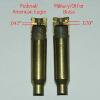TheClasonater
Member
- Joined
- Nov 29, 2019
- Messages
- 174
Just came across som LC brass and intend to work up loads for a couple 308 m77 bolt guns with Speer 150 grn hot cors and IMR 4064. I've never loaded LC brass but am gearing up start with 556 as well. I have a swager coming in the mail to head of those questions.
Now for the conundrum. The manuals I have start data around 43 grns with IMR 4064. And of course, I go reading the forums and red flags and sirens start going off every where that even starting loads could be over pressure. I have no problems starting below minimums, but how low should I go. There is only so much powder and so many bullets right now if you catch my drift. I do have some blc2 on hand but would rather save it for other loads.
Now for the conundrum. The manuals I have start data around 43 grns with IMR 4064. And of course, I go reading the forums and red flags and sirens start going off every where that even starting loads could be over pressure. I have no problems starting below minimums, but how low should I go. There is only so much powder and so many bullets right now if you catch my drift. I do have some blc2 on hand but would rather save it for other loads.


